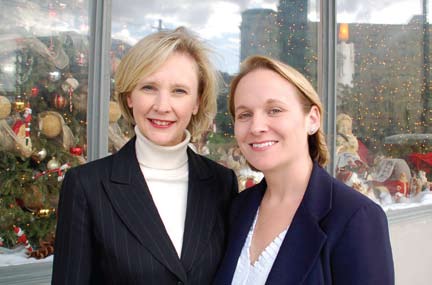When that partnership ended in 1991, NOBA reshaped itself again, presenting dance performances and, with partners like the New Orleans Recreational Department, providing free dance classes and programs for local youth. After Hurricane Katrina, NOBA lost its performance space, the Mahalia Jackson Theatre, and 12 of its 14 educational facilities. These challenges didn’t deter the group, however. Using Tulane’s Dixon Hall for its performances and expanding its educational partnerships, NOBA has continued to serve a two-tiered function. Recently, I interviewed executive director Jenny Hamilton and director of education Suzanne Stack Hirsch about NOBA’s great work.
NOL: How would you describe NOBA?
Jenny Hamilton: NOBA is a dance presenter and service organization, and over 90 percent of what we do in the community is free. The organization has two primary arms, including the Main Stage Series, where internationally and nationally renowned companies perform. We also have this extraordinary, nationally recognized education program that Suzanne oversees, which continues to grow, especially since Katrina.
What kind of role has arts education played since the storm?
Suzanne Stack Hirsch: NOBA has a long history of arts education. Post-Katrina, these programs were more necessary as families returned to the community with little or no after-school programming. Our programs provide year-round activities that are consistent in quality for youth ages 6 to 18. Parents constantly state that our classes offer a sense of community to their children. We work with a psychologist, nutritionist and our partners to offer comprehensive programs for the whole child and their family.
Do the touring companies work with the students?
SSH: This year, every company will provide master classes and other activities through our in-school and after-school programs.
Recently NOBA presented Ma Maison, a wonderful collaboration between Trey McIntyre Project and the Preservation Hall Jazz Band. How did that come about?
JH: For years, we’ve wanted to commission a renowned choreographer to create a work using New Orleans jazz music. Trey is an amazing choreographer [who’s] created works for companies like the American Ballet Theatre and New York City Ballet. When we commissioned the work, we gave Trey one stipulation: He had to use New Orleans jazz musicians, who would perform with them at the world premiere. He visited local clubs and listened to many musicians, but kept returning to Preservation Hall. Trey and Ben Jaffe [Preservation Hall musician and proprietor] shared a unique collaboration for months to create this work that will now tour internationally.
I also want to ask about the reopening of the Mahalia Jackson Theatre and the opening night concert on January 10.
JH: The Louisiana Philharmonic and Ballet are collaborating to bring this community an extraordinary evening of dance and music. In one night, the first half of the program will feature Itzhak Perlman and the Philharmonic. The second half will feature New York City Ballet stars Wendy Whelan and Albert Evans and the San Francisco Ballet with the LPO in the pit.
The reopening allows us to bring large-scale work, such as Houston Ballet’s Marie in March and Diavolo in May. We have been fortunate post-Katrina to present at intimate venues at Tulane and NOCCA, and we hope to continue those collaborations. Our audiences have loved seeing dance in a different way.
[We’re excited] to bring back these companies, who did so much for us after the storm. Diavolo was scheduled to be here in January 2006. We had no venue for them, but they came anyway, donating an entire week—they paid for the airfare and everything—and performed in schools. That was the first residency post-Katrina by any company. In the fall of 2006, Houston Ballet created a specific program with 22 dancers for our stage at Tulane. Normally they travel with over 50 dancers.
SSH: Also, Mireille Hassenboehler, a principal dancer at Houston from New Orleans, came and taught classes to our kids for free.
What is unique about Diavolo’s work?
JH: Diavolo uses extraordinary, huge architectural set pieces, and they are fearless in how they approach movement. These sets become an integral part of the dance. It’s really extraordinary to watch because it’s unlike anything most people have seen.
How about Marie, coming up in March?
JH: The work features 77 dancers, and the Philharmonic will [use more than] 60 musicians. Plus there will be 8 to 10 young dancers from New Orleans. Marie is now being created in Houston, where it will premiere in February, and tour only to New Orleans. With lavish costumes and sets, Marie will be one of the largest productions in NOBA’s history. NOBA’s also hosting a fund-raising ball.
JH: Our annual ball by BRAVO [Ballet Resource And Volunteer Organization], will celebrate the reopening of the theater and the production. The Marie Antoinette Ball will be held on March 21 at the New Orleans Museum of Art.
How do you account for NOBA’s ongoing success?
JH: Part of it comes from recognition of the quality of the dance we present on the stage, the education programs we provide and the need we fulfill in the community through both. We’ve had a lot of loyal support over the years, from people and organizations that realize the arts are a vital part of the community and rebuilding of New Orleans.

